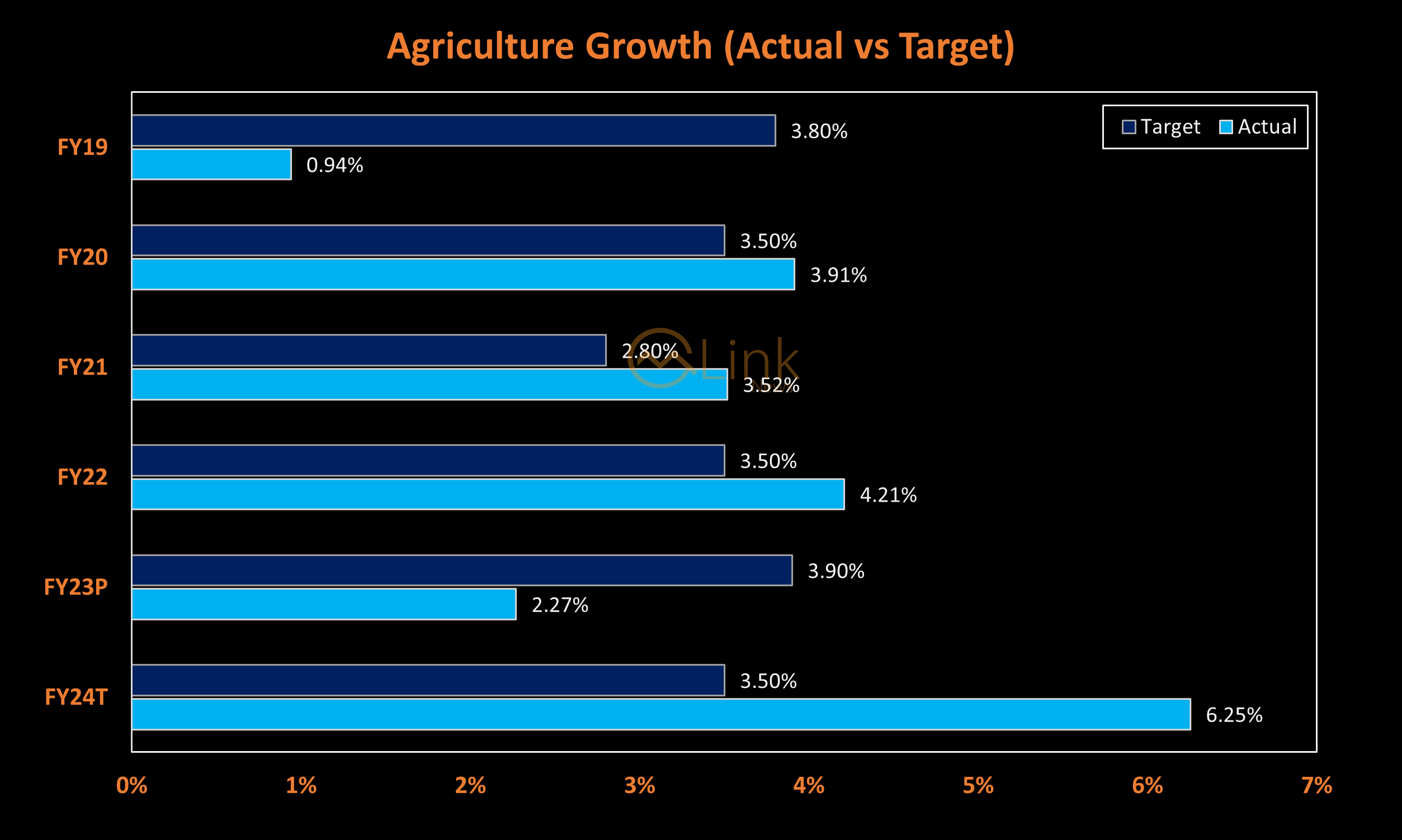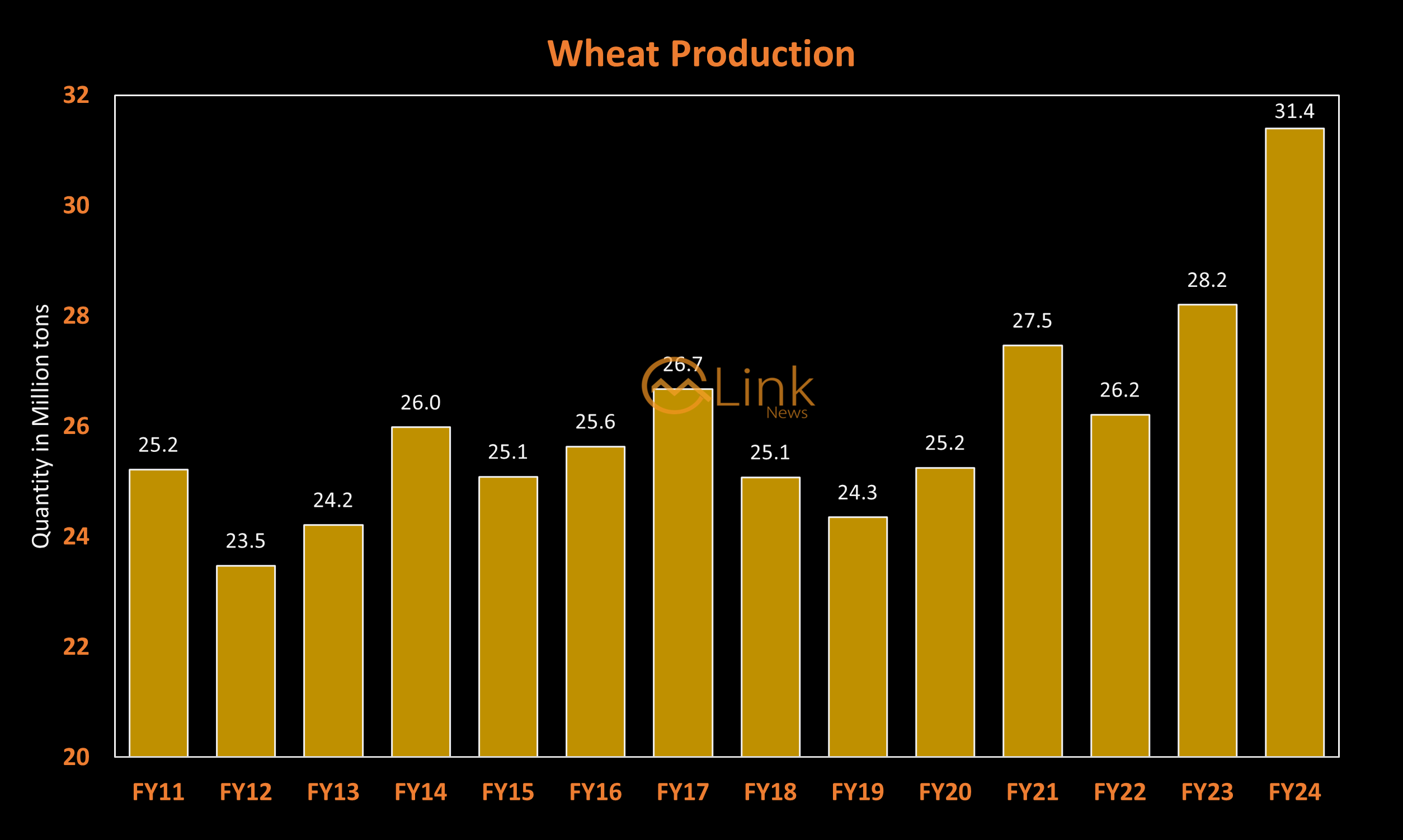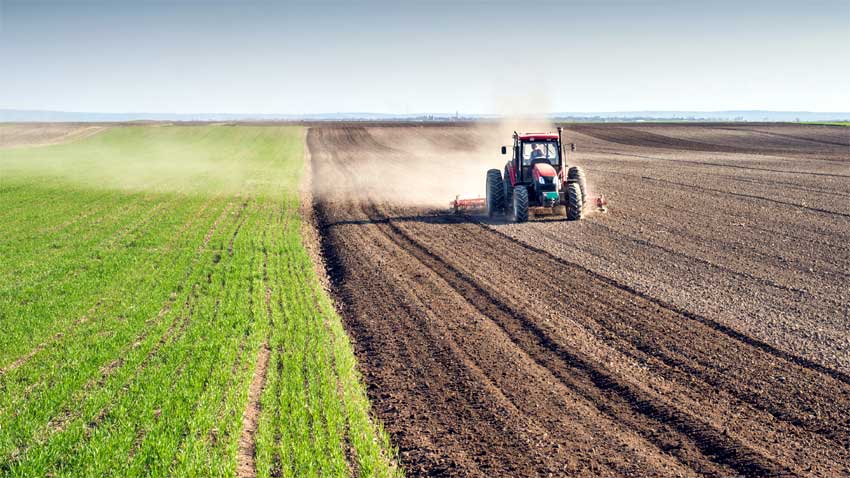June 11, 2024 (MLN): Pakistan’s agriculture sector witnessed robust growth of 6.25% in FY2024, up from 2.27% in the previous fiscal year and significantly exceeding the set target of 3.5%, as highlighted in the Pakistan Economic Report FY24 published today.
Pakistan has a diversified economic base with the agriculture sector, contributing 24% in GDP and 37.4% in employment.
It is worth adding here that this marks the highest growth rate witnessed by the country's agriculture sector in the past 19 years, being the key driver of economic growth in FY24.

Crop Position
During 2023-24, the critical crops contributed 20.67% to value addition in agriculture and 4.97% to GDP. Other crops contributed 13.51% in value addition to agriculture and 3.25% in GDP.
i) Cotton
During 2023-24, cotton area cultivation increased to 2.4 million hectares (ha) against 2.1 million ha last year, showing a growth of only 13.1%. In contrast, its production recorded a remarkable increase of 108.2% to 10.2m bales.
This overall improvement in production is linked to a better quality of pest-resilient seeds, favorable weather conditions, and attractive fixation of the intervention price of cotton (Phutti) at Rs8,500/40 kg at the start of the sowing season.

ii) Sugarcane
During 2023-24, sugarcane was cultivated on 1.2 million ha, showing a decrease of 10.5% compared to 1.3m ha last year. It has a share of 0.8% in GDP and 3.5% in agriculture value addition.
Its production slightly declined to 0.4% in 2023-24 to 87.6 million tonnes over 88m tonnes last year.
Though the total production area has decreased, the yield increase (Kg/ha) is encouraging, highlighting the optimal agriculture policy mix.
iii) Rice
Rice remained the promising crop 2023-24; its area significantly increased by 22.2% to 3.6m ha from 3m ha. Its production increased 34.8% to 9.9 million tonnes in 2023-24 against 7.3m tonnes last year.
It has a share of 0.6% in GDP and 2.5% in agriculture value addition.
The rise in rice production was due to increased area under cultivation, supported by higher rice prices, favorable monsoon rains, and better export prospects since last year.

iv) Wheat
Wheat was sown at 9.6m ha against last year’s area of 9m ha, showing an increase of 6.6%.
Wheat production stood at 31.4m tonnes compared to 28.2m tonnes last year, and a growth of 11.6% was observed in wheat production.
The government has maintained the MSP at Rs3,900/40 kg for 2023- 24.

v) Maize
During 2023-24, maize crop was cultivated on 1.6 million ha, showing a decrease of 4.5% over last year’s cultivation of 1.7m ha.
Its production declined 10.4% to 9.8m tonnes from 11m last year. It has a share of 0.7% in GDP and 2.9% in agriculture value addition.
The decline in production is due to less cultivation than the previous year.
Other crops have also shown a growth of 0.90% as compared to the contraction of 0.92% last year because of growth in fruits (8.40%), vegetables (5.77%) and pulses (1.45%).
Livestock and Poultry
The gross value addition of the livestock sector has shown an increase, rising to Rs5,804 billion in 2023-24 from Rs5,587bn in 2022-23, marking a growth rate of 3.9%.
Moreover, the sector's net foreign exchange earnings make a meaningful contribution, accounting for approximately 1.6 percent of the total exports in the country.
The poultry sector is a vibrant component of the livestock industry, providing employment opportunities to over 1.5 million people in the country.
With a substantial investment of more than Rs1,056bn, this industry has experienced impressive growth, averaging a remarkable 7.3% annual growth rate over the past decade.
This expansion has led to Pakistan becoming the eleventh largest poultry producer in the world, with vast potential for future growth and advancement.
Farm Inputs
i) Fertilizer
Overall domestic production of fertilizers during FY2024 (July-March) increased by 17.3% to 3.253 million tons over the same period of FY2023 (2.773 million tons), while import of fertilizer also increased by 23.7% (524 thousand tons).
Hence, fertilizer availability increased by 18.1% (3.776m tons). Total offtake of fertilizer nutrients also increased by 18.7% (3.957m tons).
This offtake seems high due to the extraordinarily low offtake during the previous year due to floods.
Though gas prices for urea plants increased, the average prices of urea and other nitrogen containing fertilizers were mismatched with increased gas prices and were unjustifiably high.
Moreover, the government decided to import urea on 23rd October 2023. Imported urea (by Trading Corporation of Pakistan) landed between 20th December 2023 and 31st January Agriculture 31 2024.
After a series of negotiations with the local urea industry, a mechanism was agreed upon, and marketing of imported urea started in mid-February 2024.
ii) Seeds
Seeds sector, the major input needful for gaining better output from agriculture witnessed major achievements.
Seed Business Regulation Committee (SBRC), in its 5th, 6th & 7th meetings, had recommended accepting submitted applications of 134 seed companies as local seed producers were directed to submit performance agreements and performance bonds by their five-year seed production for obtaining registration certificates to do seed business.
SBRC had accepted applications of 80 seed companies as Seed Importers on fulfillment of preliminary requirements as laid down in amended rules
iii) Farm Machinery
Under the FY2024 budget, the following steps were taken to promote agricultural productivity;
- Electricity/diesel bills are among the most significant expenses for farmers. An allocation of Rs 30.0 billion has been made to switch 50,000 agricultural tubewells to solar energy
- To increase rice production, seeders, Rice Planters, and Dryers are exempted from duties and taxes
iv) Irrigation
The monsoon season (July-September) 2023 recorded above-average rainfall,146.4 mm, showing an increase of 3.9% against the normal average rainfall of 140.9 mm.
During the post-monsoon season (October-December) 2023, rainfall was recorded at 26.8 mm against the normal average rainfall of 26.4 mm, showing an increase of 1.3%.
However, during the winter (January-March) 2024, rainfall remained above 80.8 mm against the normal average rainfall of 74.3 mm, showing an increase of 8.8%.
Agriculture Credit
To increase the flow of credit to the agriculture sector, the State Bank of Pakistan (SBP) has allocated an indicative disbursement target of Rs 2,250 billion for FY2024, which is 26.7 percent higher than last year’s disbursement of Rs 1,776 billion.
Currently, 47 financial institutions are providing agriculture loans to the farming community, which include five major commercial banks, 13 medium & small sized commercial banks, 6 Islamic banks, 2 specialized banks and 11 microfinance banks besides 10 Microfinance Institutions/Rural Support Programmes.
During July-March FY2024, the agriculture lending financial institutions disbursed Rs1,635.2bn, which is 72.7% of the overall annual target and 33.8% higher than Rs1,221.9bn disbursed during the same period last year.
Further, the outstanding portfolio of agricultural loans increased by Rs105.8bn, reaching Rs 818.7bn at the end of March 2024, compared to Rs 712.9 billion at the end of March 2023, witnessing 14.8% growth.
In terms of outreach, the number of outstanding borrowers reached 2.70 million at the end of March 2024.
Forestry
Forestry, having a share of 2.33% in agriculture, grew by 3.05% compared to 16.63% last year
M/o CC&EC is implementing Green PakistanUpscaling Programme, Phase-I across the country with the overall objective of reviving forestry and wildlife resources.
The total cost is Rs125.184bn. Under the programme, the plantation target of sowing, re-growing and distributing 2.12 billion plants has been accomplished at the national level.
The programme is under revision for the next four years (2024-2028) with an extended scope of including carbon finance mechanism through facilitation of carbon project development, scientific assessment of natural resources, livelihood creation for local communities and overall biodiversity conservation.
Climatic conditions, rural poverty, dependence on natural resources, meagre forest cover, and deforestation have rendered the country as one of the most vulnerable to climate change effects.
Besides, these resources are under tremendous pressure owing to changes in land use and habitat destruction and population pressure for fuel wood and timber.
Fisheries
Fishing, with a sectoral share of 1.30% has shown a growth of 0.81% against 0.60% during last year.
Pakistan's export of fish and fisheries products has shown a steady increase in recent years, reflecting the growing demand for seafood in international markets.
The main export items include fresh and frozen fish, shrimp, shellfish, and processed fish products such as fillets, canned fish, and fishmeal.
Major export destinations for Pakistani fishery products include the Middle East, European Union, United States, and Southeast Asia. During FY2024 (July-March) Pakistan’s major fish buyers included China, Thailand, Malaysia, and the Middle East. Sri Lanka and Japan.
A total of 206.970 thousand metric tons of fish and fish preparations were exported.
Copyright Mettis Link News
Posted on: 2024-06-11T18:27:02+05:00







